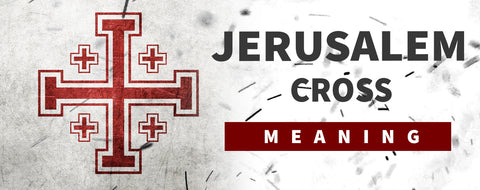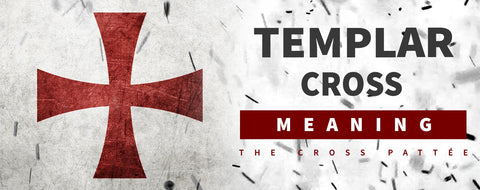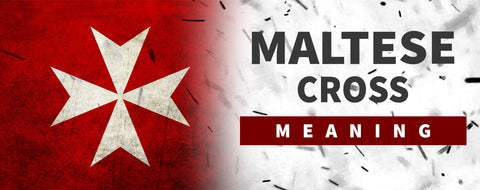
Maltese Order : Knights Hospitaller
of reading - words
The Maltese Order was founded in 1048. It was the First Knight Order created to take on the military defense of the pilgrims, sick and the captured territories. We will try to find out more in this blog article about the hospitaller order and its origins. Why was this order created ? How does their structure work and how are they organized ? What was their role within the Order of the Knights Templar ? In any case, we are going to try to understand more deeply the incredible history of the Maltese Order.

1) Creation of the Maltese Order : Knights Hospitaller
The Order of the Hospitallers of Saint John of Jerusalem has its origins in a hospital founded by a group led by Brother Gerard (mistakenly called Gerard Tenque) in the Holy City in the mid-11th century to accommodate pilgrims who came to pray at the tomb of Christ. For two centuries, the brothers welcomed travelers, rich or poor, sick or not, assisted the underprivileged and provided medical care to the war-wounded. Initially a religious order, it was invested with military responsibilities as early as the 12th century before becoming fully a Religious-Military Order. As proof, the appearance of brothers in arms, engaged with the Knights Templar in the defense of the Holy Places and the Latin States of the East, and the great fortress of the Krak des Chevaliers, which attests even today to the importance of the means devoted to this task. Not only the Holy Land, but also the Iberian Peninsula, are the chosen terrain for their engagement in combat and the defense of fortresses. To carry out their missions on the "front,” they can rely on resources accumulated in the "rear,” in Western Latin Christendom, thanks to a powerful network of houses and provinces. Driven out of the Holy Land at the fall of Acre in 1291 at the same time as the Knights Templar, the hospital withdrew to Cyprus before settling in Rhodes from 1310. Besieged by Suleiman the Magnificent, it took refuge in Malta at the end of 1521.

2) Organisation of the Order of St John of Jerusalem
Around 1130 Raymond du Puy wrote and applied a first rule modeled on that of Saint Augustine. The rule of Saint Augustine is certainly the most communitarian rule, it insists more on sharing than detachment, more on communion than chastity and more on harmony than obedience. Composed in Latin, it has nineteen chapters:
- How the brothers should make their profession
- The rights to which the brothers are entitled
- The behavior of the brethren, the service of the churches, the reception of the sick
- How the brothers should behave outdoors
- Whom should collect alms and how?
- From almsgiving and plowing of houses
- Which brethren can go and preach and in what way
- Sheets and food from the brothers
- Brethren who commit the sin of fornication
- brothers fighting with other brothers and beating them up...
- From the silence of the brothers
- Brothers who misbehave
- Brothers found in possession of their own property
- Offices that must be celebrated for the deceased brethren
- How the statutes, referred to above, are to be strictly adhered to.
- How sick lords are to be welcomed and served
- In what way can brothers correct other brothers?
- How does one brother accuse another brother
- The brothers must wear the sign of the cross on their chest...

This rule clearly establishes three things, it is indeed a monastic rule, it speaks twice of welcoming the sick and it fixes the distinctive sign of the Crusaders, the sign of the cross on the chest, for the Brothers Hospitallers the tabard will be black and the cross will be white. The exact date of the approval of the rule by Pope Eugene III is not known exactly, but historians place it before 1159. It is now possible to speak of the fraternity of the Hospital: "It is the convergence between the setting up of the first regional administrative structures and the elaboration of the rule by Master Raymond du Puy and its approval by Pope Eugene III in the middle of the 12th century that makes it possible to say that, then and only then, the Hospital became an order.” A new order was born, the Hospitaller Order of Saint John of Jerusalem.
3) The Maritime Power of the Order
Having found refuge on the island of Cyprus and settled in Limassol, the Hospitallers found that the city was open to ransacking by Arab pirates. The chapter having refused to settle in Italy in order to stay as close as possible to the Holy Land to be reconquered, it became clear that a fleet would have to be armed to defend the island. In the Holy Land, the Order armed a few buildings that allowed members of the Order to move around and convoy pilgrims. A number of these ended up in Cyprus having brought refugees and friars from Palestine and others brought the participants in the General Chapter from Europe. The historian of the Order Giacomo Bosio (1594-1602) wrote: "Soon several small buildings of different sizes were seen leaving the various ports of the island, often returning with considerable catches from the unfaithful corsairs.” Established on an island, they had no other way to continue the fight than to go out to sea and pay themselves on the enemy. If unfaithful pirates criss-crossed the seas to kidnap pilgrims, the pretext was perfect to justify a war of war. These two new activities of the Order, the navy and the race, will give the Hospitallers the means of a new power.

In 1306 Pope Clement V authorized the new Grand Master Foulques de Villaret (1305-1319) to arm a fleet without the authorization of Henry II King of Cyprus. The Order then had at its disposal two galleys, fust, a galleon and two dromons. In this region of the eastern Mediterranean, the very jagged coastline, with little access by land, and the presence of numerous islands, provided pirates with numerous lairs, which encouraged all kinds of commercial and human trafficking. At this time, the island of Rhodes is a safe haven for all these traffics. Based in Malta, the Order developed its maritime power and maintained peace in the Mediterranean by fighting the Ottomans and Barbarians, although its fleet was much smaller in naval units than the Muslim fleets. Serving on the Order's galleys became an obligatory passage for all aspiring knights, who were often received into the Order of St. John of Jerusalem at a very early age. The noble families, mostly French, paid a golden price for their sons to pass through Malta to become pages of the Grand Master or other dignitaries of the Order. After a novitiate period of twelve months, the novices became knights when they took their vows. They then had to make their caravans. These caravans, three in number (four in the 17th century), generally lasted six months each and formed between twenty and thirty knights per galley. The Order's fleet quickly became a kind of early naval academy of great reputation, attracting nobles of foreign nationalities to the Order, such as Russians or Swedes, who volunteered for two or three years. This is how great naval personalities were trained in the Order's maritime incubator. When it was necessary to recreate a French navy to affirm France's maritime power, Cardinal de Richelieu chose the naval tradition of the Order of Saint John of Jerusalem as a model.

4) The Order as a Colonial Power
Already in the 16th century, a Hospitaller, Nicolas Durand de Villegagnon, commanded the fleet of Gaspard II de Coligny, who colonized the coast of Brazil under the name of Antarctic France. He gave his name to the Ilha Villegaignon in the bay of Rio de Janeiro. In the 17th century, during the French colonization of the Americas, among the administrators were Knights Hospitallers of the Order of Saint John of Jerusalem such as Aymar de Chaste, Isaac de Razilly in Acadia, Charles Jacques Huault de Montmagny in Quebec or Philippe de Longvilliers de Poincy in the West Indies. They participated in the colonization as representatives of the King of France but not as members of the Order. But from 1651 until 1665, the Hospitallers intervened on their behalf as colonizer administrator in the West Indies. Already in 1635, Razilly unsuccessfully proposed to Grand Master Antoine de Paulo to establish a priory and commanderies in Acadia. Poincy, who had served under Razilly as a fort commander in Acadia, shared his superior views. Poincy was appointed governor of Île Saint-Christophe on behalf of the Company of the Islands of America before being appointed lieutenant-general for the Caribbean by Louis XIII in February 1639. Poincy will invest personally in the development of the island. In 1640 he charged François Levasseur to take possession of Turtle Island. His action is considered as too independent from his sponsors. The Maltese Order also reproached him for using the products he obtained from his French commandery to maintain a lifestyle that was not compatible with that of a member of the Order of Saint John of Jerusalem. He was finally replaced by Noël Patrocle de Thoisy on 25 February 1645.
On 25 November 1645, Poincy opposed Thoisy's landing at Saint-Christophe. After many adventures Poincy had Thoisy delivered as a prisoner and sent him back to France in 1647. Despite the support of the Knights of the Order of Saint John of Jerusalem at the King's court, Poincy had to pay Thoisy 90,000 pounds in compensation. Remaining in Saint-Christophe, Philippe de Longvilliers de Poincy established in 1648 the first European colony on Saint-Barthélemy and sent a reinforcement of 300 men to Saint-Martin to reinforce the small French colony in parallel to the Treaty of Concordia which fixed the border between the French and Dutch settlements, a treaty still in force today. In 1650 he founded a colony on St. Croix. In 1651, the Company of the Islands of America went bankrupt and Poincy succeeded in convincing the Grand Master of the Order of Saint John of Jerusalem Jean-Paul de Lascaris-Castellar to buy Saint-Christophe, Saint-Barthélemy, Saint-Martin and Sainte-Croix for 120,000 ecus. It was Jacques de Souvré who negotiated the agreement, which was confirmed in 1653 by the King of France, Louis XIV, who remained sovereign of the islands. The Hospitallers have temporal and spiritual jurisdiction over their islands on condition that they appoint only knights of the languages of the Kingdom of France and provide the King with ECU 1 000 of gold each anniversary year. Philippe de Longvilliers de Poincy is confirmed as governor but the Order appoints Charles Jacques Huault de Montmagny, former governor of New France, "general proconsul" with a seat in Saint-Christophe with the mission of transferring the profits of the colonies to the Order's general convent. The precedent of Noël Patrocle de Thoisy commits Montmagny to prudence and when he learns that Poincy refuses to recognize him as general proconsul, he returns to France.
The Order dismissed him in 1653 with the title of "lieutenant governor" and, faced with Poincy's repeated refusal, Montmagny withdrew to Cayonne to await Poincy's death. But Montmagny died in 1657, three years before Poincy. The Order of Saint John of Jerusalem appoints Charles de Sales, the new "lieutenant governor" from 1660 to 1664, who is easily accepted by the population. But the situation is increasingly difficult: the treaty signed by Poincy shortly before his death with the English and the Caribbean last little the income that the Hospitallers get from their settlements are of little return. In 1660, the Order still owed money to France for the purchase of the islands. Colbert, who was very interested in the development of the colonies, put pressure on the Hospitallers to recover their islands. The Order of Saint John of Jerusalem, while Claude de Roux de Saint-Laurent was "lieutenant governor" in 1665, ceded its West Indian colonies to the newly formed French West India Company, thus ending 14 years of colonial management.
5) The Hospitallers and Medicine
From the 16th to the 17th century, the Hospitallers developed medical and surgical techniques like opium-soaked sponges that patients sucked until they fainted. But it all really began with the Hospital of Jerusalem in the 12th century (Roger de Moulins's statutes of 14 March 1182 made it official for the first time among the Order's nursing staff, doctors and surgeons, and then with that of Rhodes. In 1523 the Hospitallers innovated in emergency medicine by creating the first hospital ship with the caraque Santa Maria. They invented field infirmaries under tents in order to be able to treat soldiers wounded during the war against the Ottoman corsair Dragut in 1550. At the same time, between 1530 and 1532, Grand Master Philippe de Villiers de L'Isle-Adam created a "Health Commission" composed of two knights and three notables and recreated a large hospital, the Sacra Infermeria (the Sacred Infirmary) and an apothecary in Malta. In 1595, a medical school was created, then in 1676, the school of anatomy and surgery, then the Maltese School of Pharmacy in 1677 and finally in 1687, the medical library. But it was in 1771 that the famous University of Medicine was created, which added to the influence of the Hospitaliers throughout the Mediterranean but also throughout the western world in 1794, when the dissection chair was created. The School of Mathematics and Nautical Sciences was also established at the University of Malta in 1782.

6) The Robespierre brothers, Bonaparte and the Hospitallers
Following the example of the Knights Templar, the Order of the Hospitallers became a military order in 1123, with three categories: friar chaplains, friar knights and friar servants. This organization in three classes without subdivision will always remain that of the Hospitallers, the name finally given to the members of the Order of Saint John of Jerusalem. Unlike the Knights Templar, the Hospitallers understood as soon as they returned to France after losing the Latin States in 1291 that the political climate was not good for them. The Hospitallers therefore immediately placed themselves at the service of King Philip IV the Fair and renounced the authority of the Pope, which saved their lives. The Knights Templar remained faithful to the Pope and alienated the king, so much so that the latter finally considered their extermination.

The Hospitallers, with their opportunistic vision, were called traitors by the Knights Templar. Throughout their eventful history, the Knights Hospitallers became successively Knights of Cyprus, then Knights of Rhodes and finally Knights of Malta. Even if the military aspect took over during their occupation of the island of Malta, the Order always kept a hospitable dimension. Their hospital in Valletta, Malta, was in the 18th century one of the best in Europe. But with the advent of the French Revolution the tide turned for these opportunistic Hospitallers. Contrary to what you might think, Maximilian Robespierre believed in God, but he was deeply disgusted by the behavior of a large number of clergymen. He did not like the Hospitallers, whom he considered traitors to the Pope, and he preferred the Knights Templar, who in his eyes were integral men who had been unjustly treated by the French Royalty and the French Church. Augustin Robespierre, Maximilian's younger brother, was very friendly with the young lieutenant Bonaparte (also a very religious man) whom he helped promote to the rank of General following the victorious siege of Toulon against the English. The two men thought very highly of each other and Augustine pleaded (among other things) the cause of the Knights Templar with his friend Bonaparte between 1793 and 1794 when Augustin was the Nation's representative on a mission for the army (that of the south of France and Italy). Bonaparte learned the lesson about the tragic end of the Knights Templar, and, like the Robespierre brothers, he considered the Hospitallers as traitors and despoilers of the Order of the Knights Templar. The capitulation was signed on board the Orient on June 12 at two o'clock in the morning by Grand Master Ferdinand von Hompesch zu Bolheim.

In 1798 Bonaparte set out on the Egyptian campaign, but before that, on June 12, he stopped in Malta to avenge the Templars. The knights of the Order of St. John of Jerusalem handed over (without fighting) the city and the forts of Valletta to the French army. They renounce, in favor of the French Republic, the rights of sovereignty and ownership they have over the city and the islands of Malta, Gozzo and Cumino. The Order, which had placed itself under the protection of Paul I of Russia after his banishment by Bonaparte, saw a majority of its knights go into exile in St. Petersburg, where they elected the Czar as Grand Master in 1798. However, with the abdication of Grand Master Ferdinand de Hompesch in 1799 and the death of Paul I in 1801, a dark period began for the Maltese Order, which was to continue until its break-up into competing orders. In addition to the historical orders resulting from the Protestant split, such as the very venerable Order of St. John, its main Catholic successor is the Sovereign Military Hospitaller Order of St. John of Jerusalem, Rhodes and Malta (officially founded in 1961). Having become Emperor, Bonaparte, who had retained all his admiration for the Robespierre brothers, granted in 1804 a life pension to their sister (Charlotte) who had been living in hiding and in the greatest denial since his two brothers had been beheaded in 1794, he returned in the process to the French clergy a large part of the property that had been confiscated during the revolution. Finally, it should be noted that Bonaparte worked for the renewal of Templarism from 1806, and his successors (Louis XVIII, Charles X, Louis Philippe) followed in his footsteps.








Anil Uner Erden
They are My Christian Heroes. They defended My Christian Faith and Christian Crosses